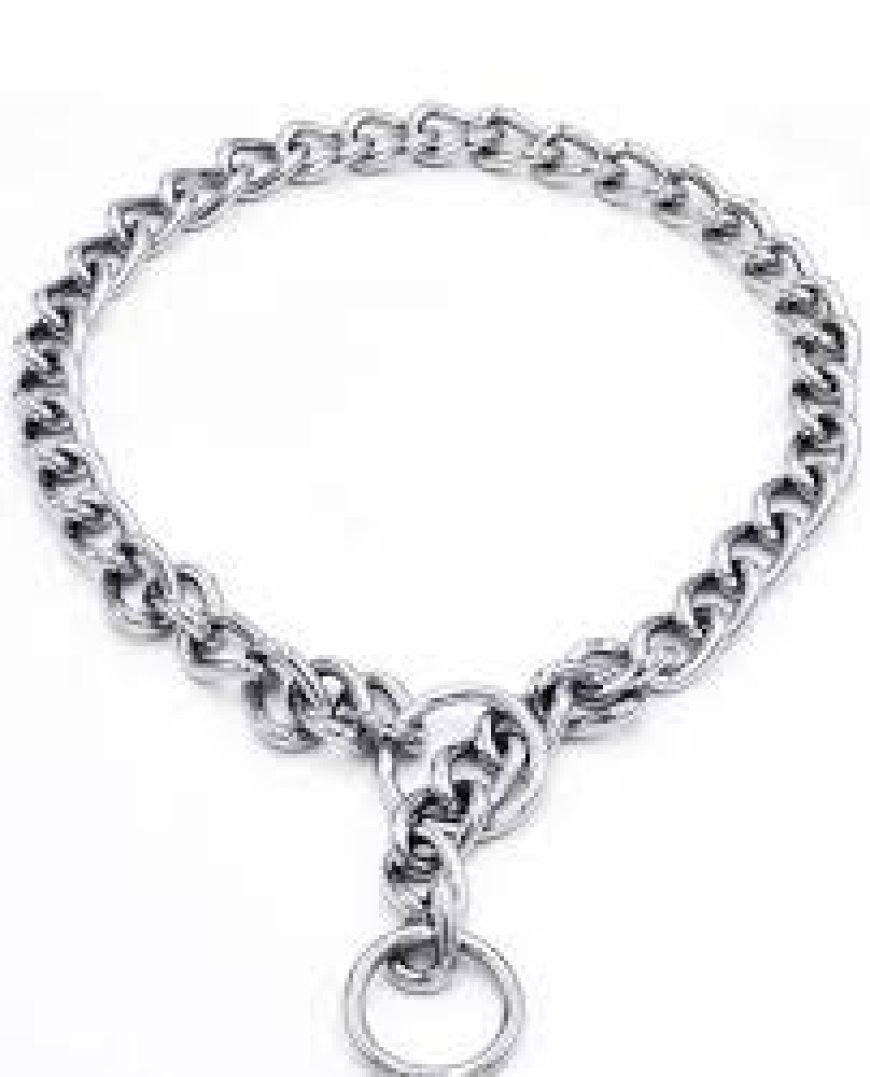Best Choke Chain | Explore Now
Choke chains, also known as slip collars or choke collars, have been a topic of debate in the world of dog training.

Choke chains, also known as slip collars or choke collars, have been a topic of debate in the world of dog training. These collars are designed to tighten around a dog’s neck when tension is applied, with the goal of discouraging undesirable behaviours such as pulling on the leash. However, their use raises questions about their effectiveness, safety, and potential to cause harm to dogs. In this comprehensive guide, we’ll explore everything you need to know about choke chains, including their usage, benefits, risks, and alternatives. Additionally, we’ll delve into the realm of pet foods, discussing the importance of nutrition for our furry companions and addressing common questions and concerns of pet owners.
Understanding Choke Chain:
Choke chains consist of a metal chain looped through itself, creating a collar that tightens around a dog’s neck when tension is applied. The idea behind their use is to apply a correctional signal to the dog when it exhibits unwanted behaviour, such as pulling on the leash. When the dog pulls, the choke chain tightens, creating discomfort or pressure around the neck, which is meant to discourage the behaviour. Proponents of choke chain argue that they provide quick and effective correction, leading to faster learning and obedience. However, critics raise concerns about the potential for physical harm and psychological distress caused by these collars.
Pros of Using Choke Chain:
Immediate Correction: Choke chains provide immediate feedback to the dog when it engages in undesirable behaviour, such as pulling on the leash.
Control: Choke chains offer handlers a level of control over the dog’s movements, particularly in situations where strong corrections are necessary.
Versatility: Choke chains can be used for a variety of training purposes, including obedience training, leash training, and behaviour modification.
Affordability: Choke chains are often more affordable than other training collars or devices, making them accessible to dog owners on a budget.
Traditional Training Method: Choke chains have been used for decades as a training tool, with some trainers advocating for their effectiveness in certain situations.
Easy to Use: Choke chains require minimal adjustment and can be easily put on and taken off the dog.
Cons of Using Choke Chains:
Potential for Injury: Choke chains can cause injury to the dog’s neck, throat, or trachea if used incorrectly or with excessive force.
Risk of Pain and Discomfort: The tightening action of choke chains can cause pain, discomfort, and distress to the dog, potentially leading to negative associations with training.
Limited Effectiveness: Some dogs may become desensitised to the discomfort caused by choke chains, leading to a lack of response to corrections.
Negative Psychological Impact: The use of aversive training methods like choke chains can lead to fear, anxiety, and aggression in dogs, undermining the bond between the dog and its handler.
Not Suitable for All Dogs: Choke chains may not be appropriate for dogs with respiratory issues, neck injuries, or brachycephalic breeds with shortened airways.
Lack of Positive Reinforcement: Choke chains focus on punishment rather than positive reinforcement, potentially hindering the dog’s ability to learn and retain desired behaviours.
Conclusion:
While choke chains have been used as a training tool for decades, their effectiveness and safety remain subjects of debate among dog trainers, behaviourists, and veterinarians. While some argue that choke chains provide quick and effective correction, others raise concerns about the potential for physical harm and psychological distress caused by these collars. Ultimately, the decision to use a choke chain should be made carefully, taking into consideration the individual needs, temperament, and behaviour of the dog. In many cases, positive reinforcement-based training methods that focus on rewarding desired behaviours offer a safer and more humane alternative to choke chains.
Frequently Asked Questions (FAQs) about Choke Chains:
Are choke chains safe for all dogs?
No, choke chains may not be suitable for dogs with respiratory issues, neck injuries, or brachycephalic breeds with shortened airways.
How should I properly use a choke chain for training?
Choke chains should be used with caution and under the guidance of a qualified dog trainer. It’s essential to avoid using excessive force or jerking motions that could injure the dog.
Are there alternatives to choke chains for training?
Yes, positive reinforcement-based training methods that focus on rewarding desired behaviours offer a safer and more humane alternative to choke chains.
Do choke chains cause pain to dogs?
The tightening action of choke chains can cause pain, discomfort, and distress to the dog, particularly if used incorrectly or with excessive force.
Can choke chains lead to aggression in dogs?
The use of aversive training methods like choke chains can lead to fear, anxiety, and aggression in dogs, potentially undermining the bond between the dog and its handler.
Are there specific breeds that are more responsive to choke chain training?
Some trainers believe that certain breeds may be more responsive to choke chain training, but individual temperament and behaviour should always be taken into consideration.
What should I do if my dog exhibits negative reactions to a choke chain?
If your dog exhibits signs of pain, discomfort, fear, or aggression in response to a choke chain, it’s essential to discontinue its use immediately and consult with a qualified dog trainer or behaviourist.
Can choke chains be used for puppies?
Choke chains are not recommended for use on puppies, as their delicate necks are more susceptible to injury. Positive reinforcement-based training methods are generally more appropriate for young dogs.












